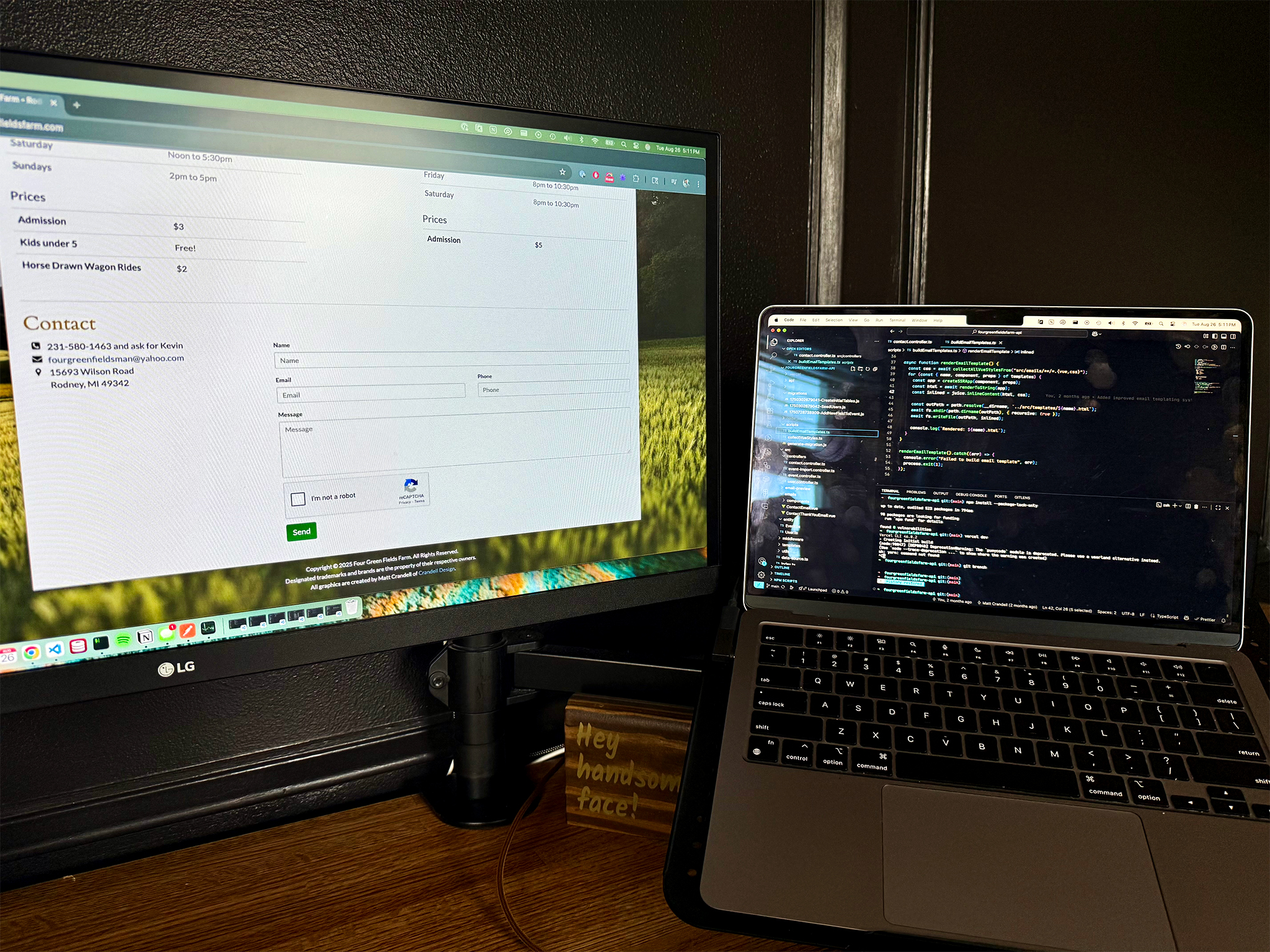Building a Scalable Email System with Vue and Inline Styles
In Part 1 and 2, I walked through how I built a clean API with authentication, CSV imports, and recurring event logic. But one piece was still missing: emails. While Four Green Fields Farm’s website only has a simple contact form, I thought this was a good time to streamline everything. And let’s be real: building emails is rarely fun.
This post is about how I set up a Vue-powered email templating system, fully inlined for email client compatibility, and structured in a way that’s ready for growth.
Why Vue for Emails?
I could have gone with static MJML or Handlebars templates, but Vue gave me two major advantages:
- Component reuse — A shared
<EmailHeader />and<EmailFooter />means every new template stays consistent. - Developer experience — Writing templates felt just like building small Vue apps, with props and scoped styles instead of coding like it’s 1994.
Rendering Vue to Inline-Ready HTML
The magic happens in a buildEmailTemplates.ts script. Instead of serving Vue on the client, I used Vue’s @vue/server-renderer to convert .vue components into raw HTML. Then I ran that HTML through Juice, which inlines all CSS for email client compatibility.
Here’s the gist:
import { renderToString } from "@vue/server-renderer";
import juice from "juice";
import fs from "fs";
import path from "path";
import { createSSRApp } from "vue";
async function renderEmail(component: any, props = {}) {
const app = createSSRApp(component, props);
let html = await renderToString(app);
return juice(html);
}
// Example: render ContactEmail.vue
The output is a ready-to-send HTML string with styles fully inlined. No more surprises in Gmail or Outlook.
Headers, Footers, and Style Pain
Emails aren’t just isolated templates. They usually share structure — headers, footers, and consistent typography. I built a <Header /> and <Footer /> component and dropped them into each email layout. Easy enough, right?
Not quite. The styles immediately broke. Since I was compiling down to HTML, external CSS files weren’t going to cut it. I needed to inline everything. That’s where Juice came in — a library that takes a block of HTML + a CSS string and merges the two.
The catch? Vue components don’t just hand you a single CSS file. Each .vue file has its own <style> block, and I had to aggregate them all before Juice could inline them. Enter a little helper script:
// scripts/collectVueStyles.ts
import { parse } from "@vue/compiler-sfc";
import fs from "fs/promises";
import fg from "fast-glob";
import path from "path";
export async function collectAllVueStylesFrom(
globPattern: string
): Promise<string> {
const files = await fg(globPattern, { absolute: true });
let combined = "";
for (const file of files) {
const source = await fs.readFile(file, "utf-8");
const parsed = parse(source);
for (const style of parsed.descriptor.styles) {
combined += style.content + "\n";
}
}
return combined;
}
This little script crawls through every Vue file, rips out the <style> blocks, and stitches them together into one giant CSS string.
The Build Command
Once styles were sorted, the build process became smooth. Here’s the core of it:
// scripts/buildEmailTemplates.ts
const templates = [
{
name: "contact-email",
component: ContactEmail,
props: {
name: "{{name}}",
email: "{{email}}",
phone: "{{phone}}",
message: "{{message}}",
year: "{{year}}",
},
},
{
name: "contact-thank-you-email",
component: ContactThankYouEmail,
props: { name: "{{name}}", year: "{{year}}" },
},
];
async function renderEmailTemplate() {
const css = await collectAllVueStylesFrom("src/emails/**/*.{vue,css}");
for (const { name, component, props } of templates) {
const app = createSSRApp(component, props);
const html = await renderToString(app);
const inlined = juice.inlineContent(html, css);
const outPath = path.resolve(__dirname, `../src/templates/${name}.html`);
await fs.mkdir(path.dirname(outPath), { recursive: true });
await fs.writeFile(outPath, inlined);
console.log(`Rendered: ${name}.html`);
}
}
The script runs during build, outputs fully inlined HTML templates, and drops them in src/templates/ for Mailgun to use. Each prop gets Mustache-style placeholders so I can inject data later.
Previewing Templates Locally
To make development easier, I added a small previewer you can run with:
npm run email:preview
This spins up a page with a <select> dropdown so I can toggle between templates (ContactEmail, ContactThankYouEmail, etc.) and see the final rendered result in the browser before sending.
Dynamic Data
One nice touch was moving dynamic values (like the year in the footer) into runtime props instead of hardcoding them. For example:
<template>
<footer>
<p>© {{ year }} Four Green Fields Farm</p>
</footer>
</template>
When sending, I just pass { year: new Date().getFullYear() }.
This system now gives me a scalable path forward but makes building emails a little less painful. Need a new email? Drop in a .vue file, update the preview and build commands, and you’re ready to rock.
Next time, I might wrap this up into a standalone package, but for now it’s doing exactly what I need.
